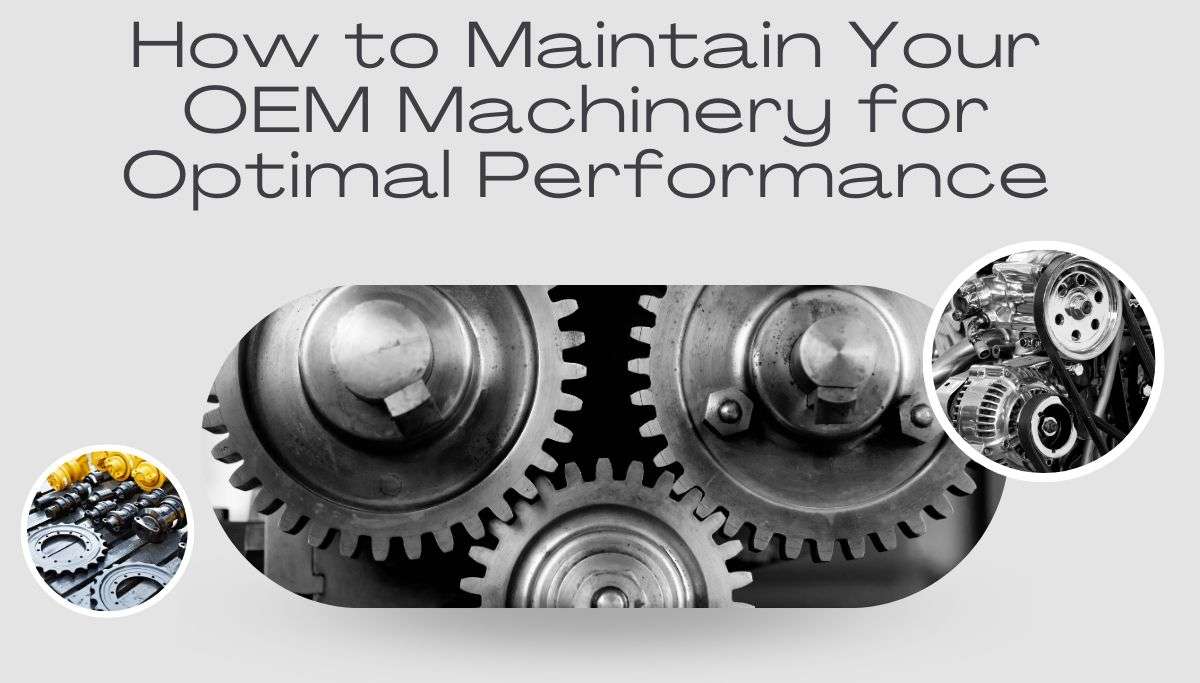
Nov 3,2023
In today's industrial landscape, Original Equipment Manufacturer (OEM) machinery plays a pivotal role in various sectors, from manufacturing and construction to healthcare and agriculture.
OEM machinery encompasses a wide range of equipment, including industrial OEM equipment, OEM manufacturing machinery, custom machinery for OEMs, and OEM machine tools. These specialized machines are the backbone of countless industries, and their proper maintenance is crucial for achieving optimal performance and efficiency.
In this blog post, we will explore the importance of maintaining your OEM machinery and provide valuable insights into developing effective maintenance strategies.
Before delving into the maintenance aspects, it's essential to have a clear understanding of the different types of OEM machinery and their applications. This knowledge will help you tailor your maintenance efforts to the specific needs of your equipment.
Industrial OEM equipment encompasses a broad spectrum of machinery used in manufacturing, processing, and assembly operations. This includes conveyor systems, robotic arms, and packaging machinery, among others.
These machines are designed for various stages of the manufacturing process, from CNC machines and injection molding equipment to 3D printers and automated assembly lines.
Custom-built machinery is tailored to the unique needs of OEMs. They often serve specialized functions in industries like healthcare, agriculture, or aerospace.
Machine tools are fundamental in precision manufacturing and include lathes, milling machines, and grinding equipment.
Maintenance is not merely a routine task; it is the lifeline of your OEM machinery. Here are some compelling reasons why proper maintenance is crucial:
Well-maintained machinery operates at its peak efficiency, ensuring that your business processes run smoothly and that you meet production targets.
Regular maintenance can significantly extend the lifespan of your machinery, saving you the cost of premature replacements.
Safe operation is paramount in any industrial setting. Proper maintenance minimizes the risk of accidents and ensures compliance with industry safety standards.
Though maintenance comes with a cost, it is a fraction of what you would spend on emergency repairs or replacements resulting from neglect.
An organized approach to maintenance is key. Developing a maintenance schedule tailored to your equipment is the foundation of efficient maintenance. It includes:
Regular Inspection and Monitoring: Schedule routine inspections to identify potential issues early on.
Preventative Maintenance Measures: Implement measures to prevent common problems and address wear and tear promptly.
Recommended Maintenance Frequencies: Consult your equipment's manual or manufacturer recommendations for specific maintenance intervals.
Record-Keeping and Documentation: Maintain detailed records of all maintenance activities, which can help in future troubleshooting.
Basic maintenance procedures form the core of keeping your OEM machinery in excellent working condition. Here's what you should focus on:
Cleaning and Lubrication: Regular cleaning and proper lubrication ensure that moving parts work smoothly and reduce friction.
Inspection of Wear and Tear: Keep an eye out for signs of wear and tear, such as worn-out belts, damaged cables, or loose bolts.
Calibration and Alignment: Precision machinery, especially machine tools, should be regularly calibrated and aligned for accurate results.
Electrical and Control System Checks: Ensure the electrical components and control systems are functioning correctly.
Software Updates and Upgrades: If your machinery is equipped with software, ensure that it is up to date for optimal performance.
In addition to basic procedures, consider employing advanced maintenance techniques to proactively manage your OEM machinery:
Troubleshooting and Diagnostics: Equip your maintenance team with the skills and tools needed to diagnose and address complex issues swiftly.
Predictive Maintenance Technologies: Utilize predictive maintenance technologies such as sensors and monitoring systems to detect potential problems before they escalate.
Replacement of Wearable Parts: Keep a stock of critical wearable parts and replace them before they fail to avoid downtime.
Upgrading for Enhanced Performance: Explore opportunities to upgrade your machinery with modern components or features that can enhance performance and efficiency.
Safety should always be a top priority during maintenance. Implement the following measures:
Safety Precautions During Maintenance: Ensure that maintenance personnel follow strict safety protocols, including lockout/tagout procedures and personal protective equipment (PPE).
Compliance with Industry Regulations: Familiarize yourself with industry-specific safety regulations and compliance standards and ensure that your maintenance practices align with them.
Training and Certification for Operators: Provide training and certification programs for equipment operators to minimize the risk of accidents caused by human error.
Deciding whether to handle maintenance in-house or outsource it is a critical choice. Consider the following factors:
In-House vs. Outsourcing: Weigh the pros and cons of maintaining an in-house maintenance team versus outsourcing to specialized service providers.
Qualities of a Reliable Maintenance Team: If you choose in-house maintenance, hire skilled professionals with the expertise to manage your machinery effectively.
Training and Skill Development: Invest in ongoing training and skill development for your maintenance team to keep them updated on the latest technologies and best practices.
Learn from real-world examples of successful maintenance efforts in your industry. Seek advice and insights from experienced professionals and industry leaders to refine your maintenance strategies.
In an ever-evolving technological landscape, it's essential to adapt your machinery to stay competitive. Consider these aspects:
Adapting to Technological Advances: Stay informed about technological advancements in your industry and be prepared to integrate them into your machinery.
Sustainability and Environmental Considerations: Explore environmentally friendly practices that can reduce your carbon footprint and lower operational costs.
Proper maintenance of your OEM machinery is the key to achieving optimal performance, extending the lifespan of your equipment, ensuring safety, and reducing long-term costs. By developing a well-structured maintenance schedule, following basic and advanced maintenance procedures, and prioritizing safety and compliance, you can keep your OEM machinery in top-notch condition. Remember that your maintenance efforts not only safeguard your investment but also contribute to the overall success of your business.